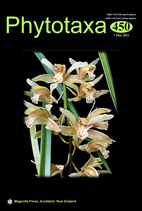Abstract
The taxonomic classification within the Neotropical cycad genus Ceratozamia (Zamiaceae) has been a challenging task because cohorts of morphological variation in association with conspicuous geographic discontinuities that delimit species are not always easy to observe. Ceratozamia robusta is one example. Although previous studies have suggested that C. robusta presents an unusually high morphological variation across populations, this variation remains unquantified. In particular, we noticed that herbarium specimens from populations in the region Los Altos de Chiapas (Chiapas Highlands) that have been considered as C. robusta notably differ from the rest of the typical C. robusta forms by having narrower leaflets and fewer prickles on the petioles. Thus, we asked whether the populations in the Chiapas Highlands correspond to C. robusta as currently circumscribed. We examined the variation of ten leaf and trunk traits of 97 adult plants from six populations of C. robusta. Variation among the ten traits was significantly differentiated across populations, and such variation is correlated with elevation. Pairwise population differentiation tests and linear discriminant analyses clearly separated three groups: 1) populations similar to the neotype of C. robusta occur at mid-elevations in Chiapas, 2) a large C. robusta form occurs at low elevations in Belize, and 3) populations in the Chiapas Highlands that differ from both. The latter have fewer leaves and leaflets, shorter rachis, arched leaves in mature plants, petioles sparsely armed with thin prickles, smaller male cones, and juvenile forms more similar to those of the C. miqueliana species complex. These results suggest that the populations from the Chiapas Highlands represent a new taxon, here described as Ceratozamia sanchezae. This study highlights the importance of quantifying morphological variation across cycad populations to identify the species delimitation in complex groups.

